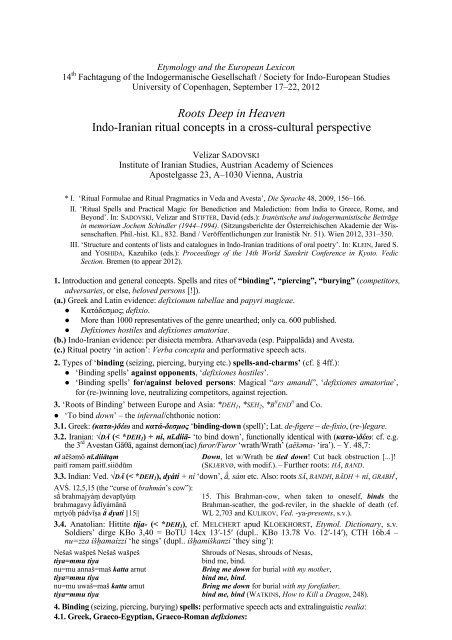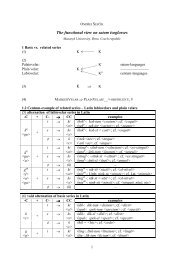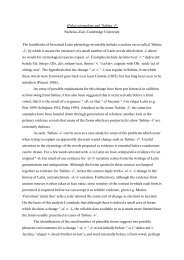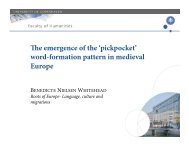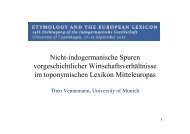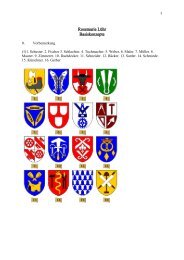Roots Deep in Heaven Indo-Iranian ritual concepts in a cross ...
Roots Deep in Heaven Indo-Iranian ritual concepts in a cross ...
Roots Deep in Heaven Indo-Iranian ritual concepts in a cross ...
You also want an ePaper? Increase the reach of your titles
YUMPU automatically turns print PDFs into web optimized ePapers that Google loves.
Etymology and the European Lexicon<br />
14 th Fachtagung of the <strong>Indo</strong>germanische Gesellschaft / Society for <strong>Indo</strong>-European Studies<br />
University of Copenhagen, September 17–22, 2012<br />
<strong>Roots</strong> <strong>Deep</strong> <strong>in</strong> <strong>Heaven</strong><br />
<strong>Indo</strong>-<strong>Iranian</strong> <strong>ritual</strong> <strong>concepts</strong> <strong>in</strong> a <strong>cross</strong>-cultural perspective<br />
Velizar SADOVSKI<br />
Institute of <strong>Iranian</strong> Studies, Austrian Academy of Sciences<br />
Apostelgasse 23, A–1030 Vienna, Austria<br />
* I. ‘Ritual Formulae and Ritual Pragmatics <strong>in</strong> Veda and Avesta’, Die Sprache 48, 2009, 156–166.<br />
II. ‘Ritual Spells and Practical Magic for Benediction and Malediction: from India to Greece, Rome, and<br />
Beyond’. In: SADOVSKI, Velizar and STIFTER, David (eds.): Iranistische und <strong>in</strong>dogermanistische Beiträge<br />
<strong>in</strong> memoriam Jochem Sch<strong>in</strong>dler (1944–1994). (Sitzungsberichte der Österreichischen Akademie der Wissenschaften.<br />
Phil.-hist. Kl., 832. Band / Veröffentlichungen zur Iranistik Nr. 51). Wien 2012, 331–350.<br />
III. ‘Structure and contents of lists and catalogues <strong>in</strong> <strong>Indo</strong>-<strong>Iranian</strong> traditions of oral poetry’. In: KLEIN, Jared S.<br />
and YOSHIDA, Kazuhiko (eds.): Proceed<strong>in</strong>gs of the 14th World Sanskrit Conference <strong>in</strong> Kyoto. Vedic<br />
Section. Bremen (to appear 2012).<br />
1. Introduction and general <strong>concepts</strong>. Spells and rites of “b<strong>in</strong>d<strong>in</strong>g”, “pierc<strong>in</strong>g”, “bury<strong>in</strong>g” (competitors,<br />
adversaries, or else, beloved persons [!]).<br />
(a.) Greek and Lat<strong>in</strong> evidence: defixionum tabellae and papyri magicae.<br />
● Κατάδεσμος; defixio.<br />
● More than 1000 representatives of the genre unearthed; only ca. 600 published.<br />
● Defixiones hostiles and defixiones amatoriae.<br />
(b.) <strong>Indo</strong>-<strong>Iranian</strong> evidence: per disiecta membra. Atharvaveda (esp. Paippalāda) and Avesta.<br />
(c.) Ritual poetry ‘<strong>in</strong> action’: Verba concepta and performative speech acts.<br />
2. Types of ‘b<strong>in</strong>d<strong>in</strong>g (seiz<strong>in</strong>g, pierc<strong>in</strong>g, bury<strong>in</strong>g etc.) spells-and-charms’ (cf. § 4ff.):<br />
● ‘B<strong>in</strong>d<strong>in</strong>g spells’ aga<strong>in</strong>st opponents, ‘defixiones hostiles’.<br />
● ‘B<strong>in</strong>d<strong>in</strong>g spells’ for/aga<strong>in</strong>st beloved persons: Magical “ars amandi”, ‘defixiones amatoriae’,<br />
for (re-)w<strong>in</strong>n<strong>in</strong>g love, neutraliz<strong>in</strong>g competitors, aga<strong>in</strong>st rejection.<br />
3. ‘<strong>Roots</strong> of B<strong>in</strong>d<strong>in</strong>g’ between Europe and Asia: *DEH1, *SEH2, *B H END H and Co.<br />
● ‘To b<strong>in</strong>d down’ – the <strong>in</strong>fernal/chthonic notion:<br />
3.1. Greek: (κατα-)δέω and κατά-δεσμος ‘b<strong>in</strong>d<strong>in</strong>g-down (spell)’; Lat. de-figere ~ de-fixio, (re-)legare.<br />
3.2. <strong>Iranian</strong>: √DĀ (< *DEH1) + ni, nī.diiā- ‘to b<strong>in</strong>d down’, functionally identical with (κατα-)δέω: cf. e.g.<br />
the 3 rd Avestan Gāθā, aga<strong>in</strong>st demon(iac) furor/Furor ‘wrath/Wrath’ (aēšəma- ‘ira’). – Y. 48,7:<br />
nī aēšəmō nī.diiātąm<br />
paitī rəməm paitī.siiōdūm<br />
Down, let w/Wrath be tied down! Cut back obstruction [...]!<br />
(SKJÆRVØ, with modif.). – Further roots: HĀ, BAND.<br />
3.3. Indian: Ved. √DĀ (< *DEH1), dyáti + ní ‘down’, ā́ , sám etc. Also: roots SĀ, BANDH, BĀDH + ní, GRABH i ,<br />
AVŚ. 12,5,15 (the “curse of brahmán’s cow”):<br />
sā ́ brahmajyáṃ devapīyúṃ<br />
15. This Brahman-cow, when taken to oneself, b<strong>in</strong>ds the<br />
brahmagavy ā̀dīyámānā<br />
Brahman-scather, the god-reviler, <strong>in</strong> the shackle of death (cf.<br />
mr̥ tyóḥ pádvīṣa ā ́ dyati ||15||<br />
WL 2,703 and KULIKOV, Ved. -ya-presents, s.v.).<br />
3.4. Anatolian: Hittite tii̯ a- (< *DEH1), cf. MELCHERT apud KLOEKHORST, Etymol. Dictionary, s.v.<br />
Soldiers’ dirge KBo 3,40 = BoTU 14cx 13ʹ-15ʹ (dupl.. KBo 13.78 Vo. 12ʹ-14ʹ), CTH 16b.4 –<br />
nu=zza išh̬ amaizzi ‘he s<strong>in</strong>gs’ (dupl.. išh̬ amiškanzi ‘they s<strong>in</strong>g’):<br />
Nešaš wašpeš Nešaš wašpeš<br />
tiya=mmu tiya<br />
nu=mu annaš=maš katta arnut<br />
tiya=mmu tiya<br />
nu=mu uwaš=maš katta arnut<br />
tiya=mmu tiya<br />
Shrouds of Nesas, shrouds of Nesas,<br />
b<strong>in</strong>d me, b<strong>in</strong>d.<br />
Br<strong>in</strong>g me down for burial with my mother,<br />
b<strong>in</strong>d me, b<strong>in</strong>d.<br />
Br<strong>in</strong>g me down for burial with my forefather,<br />
b<strong>in</strong>d me, b<strong>in</strong>d (WATKINS, How to Kill a Dragon, 248).<br />
4. B<strong>in</strong>d<strong>in</strong>g (seiz<strong>in</strong>g, pierc<strong>in</strong>g, bury<strong>in</strong>g) spells: performative speech acts and extral<strong>in</strong>guistic realia:<br />
4.1. Greek, Graeco-Egyptian, Graeco-Roman defixiones:
14 th Fachtagung of the <strong>Indo</strong>germanische Gesellschaft, Copenhagen, September 17–22, 2012 2<br />
● κατα-δῶ Χαρίαν ... καὶ ψυχὴν τὴν Χαρίου<br />
καὶ γλῶταν τὴν Χαρίου ... κατα-δῶ ψυχὴν τὴν<br />
Καλλίππο καὶ χεῖρας τὰς Καλλίππο<br />
(Kerameikos [5 th c. BC, ed. D. JORDAN, SGD 95]):<br />
I b<strong>in</strong>d down Charias... and the soul of Charias and the tongue of<br />
Charias... I b<strong>in</strong>d the soul of Kallippos... and the hands of Kallippos.<br />
For the stylistic form of body parts enumeration cf. Attica, beg. of 4 th c. BC (DTA, ed. WÜNSCH, no. 49):<br />
● Side A: (1) I b<strong>in</strong>d down Theagenes, his tongue and his soul and the words he uses; (2) I also b<strong>in</strong>d down the hands<br />
and feet of Pyrrhias, the cook, his tongue, his soul, his words; [...] (8) I also b<strong>in</strong>d down the tongue of Seuthes, his<br />
soul, and the words he uses, just like his feet, his hands, his eyes, and his mouth; (9) I also b<strong>in</strong>d down the tongue of<br />
Lamprias, his soul, and the words he uses, just like his feet, his hands, his eyes, and his mouth.<br />
All these I b<strong>in</strong>d down, I make them disappear, 1 bury them, I nail them down.<br />
● Side B: τούτους ἅπαντας κατα-δῶ ἀ-φανίζω<br />
κατ-ορύττω κατα-πασσαλεύω.<br />
All of them, I b<strong>in</strong>d them down, I make them disappear, I<br />
bury them ‘down’, I nail them down.<br />
● Most usual form <strong>in</strong> Greek καταδεσμοί – Defixionum Tabellae Atticae (= IG 3,3, ed. WÜNSCH) 86: “I b<strong>in</strong>d Dromōn<br />
... feet and hands ...”. “I b<strong>in</strong>d Isias before Hermes the Restra<strong>in</strong>er – the hands, the feet of Isias, the whole body”.<br />
4.2. <strong>Indo</strong>-<strong>Iranian</strong> tradition – b<strong>in</strong>d<strong>in</strong>g, torment<strong>in</strong>g, pierc<strong>in</strong>g spells. S. § 6 and the genre subtypes:<br />
4.2.1. ‘Body-b<strong>in</strong>d<strong>in</strong>g’ mantras aga<strong>in</strong>st competitors:<br />
́<br />
́<br />
● AVŚ. 7,73[70],4–5:<br />
ápāñcau ta ubháu bāhū<br />
Turned back/beh<strong>in</strong>d are your two arms.<br />
ápi nahyāmiy āsíyàm |<br />
I b<strong>in</strong>d (up) your mouth.<br />
agnér devásya manyúnā<br />
With the wrath of god Agni<br />
téna te ʹvadhiṣaṃ havíḥ ||4||<br />
I destroyed your oblation.<br />
ápa nahyāmi te bāhū<br />
I b<strong>in</strong>d back/away your arms,<br />
ápi nahyāmy āsyàm |<br />
I b<strong>in</strong>d (up) your mouth.<br />
agnér ghorásya manyúnā<br />
With the wrath of terrible Agni<br />
téna ʹvadhiṣaṃ havíḥ ||5||<br />
I destroyed your oblation.<br />
4.2.2. ‘Pierc<strong>in</strong>g-and-seiz<strong>in</strong>g spells’ from the Atharvaveda (AVŚ. 16,7):<br />
téna enaṃ vidhyāmiy<br />
ábhūtyā enaṃ vidhyāmi<br />
nírbhūtyā enaṃ vidhyāmi<br />
párābhūtya<strong>in</strong>aṃ vidhyāmi<br />
grā́ hiyā enaṃ vidhyāmi<br />
támasā enaṃ vidhyāmi ||1||<br />
evā́nevā́va sā<br />
1. With that I pierce him;<br />
with ill-success I pierce him;<br />
with exterm<strong>in</strong>ation I pierce him;<br />
with calamity I pierce him;<br />
with seizure I pierce him;<br />
with darkness I pierce him.<br />
́ garat ||4|| 4. Like this (‘So’), not like this (‘not so’), may she [Grāhi/<br />
Seizure] swallow [him] down.<br />
nír dviṣántaṃ divó níḥ pr̥ thivyā ́<br />
6. Let us deprive our hater of share of heaven, of earth, of<br />
nír antárikṣād bhajāma ||6||<br />
<strong>in</strong>termediary space / atmosphere (antárikṣa-).<br />
súyāmaṃś cākṣuṣa ||7|| 7. O you of good ways, provided with sight (cāksuṣá).<br />
idám ahám āmuṣyāyaṇè 'múṣyāḥ<br />
8. Now do I wipe off this evil-dream<strong>in</strong>g on him of such-<br />
putré duṣvápniyaṃ mr̥ je ||8||<br />
and-such l<strong>in</strong>eage, son of such-and-such a mother.<br />
táṃ jahi téna mandasva tásya pr̥ ṣṭī́r ápi śr̥ ṇīhi ||12|| Smite him, amuse yourself with him, crush <strong>in</strong> his ribs. (after<br />
WHITNEY – LANMAN).<br />
● Note the matri-l<strong>in</strong>eal <strong>in</strong>dication of orig<strong>in</strong> (more about which see below).<br />
● Cf. <strong>ritual</strong> act of pierc<strong>in</strong>g live animals <strong>in</strong>stead of statuettes, e.g. the tomcat from Santones buried with head<br />
twisted back (AUDOLLENT, Defixionum tabellae, no. 112; GRAF): aversos [...] esse quo/modi [sic] hic catellus<br />
aversus / est nec surgere potest / sic nec illi, sic transpecti s<strong>in</strong>t / quomodo ille ‘Let them be turned away [...] <strong>in</strong><br />
the same way that this little cat is turned away and cannot get up. Let it be thus for them as well’.<br />
5. B<strong>in</strong>d<strong>in</strong>g spells and rites “beyond <strong>Indo</strong>-European”: Rituals of b<strong>in</strong>d<strong>in</strong>g, pierc<strong>in</strong>g and bury<strong>in</strong>g<br />
figur<strong>in</strong>es (“voodoo dolls”) of enemies and beloved persons.<br />
5.1. Egyptian evidence. Magical recipes, on tablet <strong>in</strong>scriptions and papyri.<br />
5.2. Assyrian data. Maqlû <strong>in</strong>cantation series (ed. MEIER etc.). Utukkū Lemnūtu spells (ed. GELLER).<br />
5.3. Greek, Graeco-Egyptian and Roman testimonies: B<strong>in</strong>d<strong>in</strong>g and seiz<strong>in</strong>g enemies, lovers, gods.<br />
[On ‘seiz<strong>in</strong>g names’ and ‘b<strong>in</strong>d<strong>in</strong>g gods’ cf. below].<br />
Various forms of BINDING / PIERCING / BURYING spells both <strong>in</strong> hostile and <strong>in</strong> erotic spells:<br />
6. ‘TO BIND + (WITH) BOND(S)’ – between figura etymologica and variatio formae:<br />
● Ved. DĀ, dyáti (+ ní, ā́ , sám) and <strong>Indo</strong>-<strong>Iranian</strong> <strong>ritual</strong> tradition:<br />
AVŚ. 6,104[,1–3]:<br />
ādā́ nena saṃdā́ nena<br />
amítrān ā ́ diyāmasi |<br />
apānā ́ yé caiṣāṃ prāṇā ́<br />
ásunā́sūnt sám achidan ||1||<br />
idám ādā́ nam akaraṃ<br />
tápaséndreṇa sáṃśitam |<br />
1. With ty<strong>in</strong>g-up, with ty<strong>in</strong>g-together,<br />
we tie up the enemies;<br />
the expirations and breaths of them,<br />
lives with life (ásu) have I cut off.<br />
2. This ty<strong>in</strong>g-up have I made,<br />
sharpened up with fervor by Indra;
Velizar Sadovski, <strong>Indo</strong>-<strong>Iranian</strong> <strong>ritual</strong> <strong>concepts</strong> <strong>in</strong> a <strong>cross</strong>-cultural perspective, 18.09.2012 3<br />
amítrā yé ʹtra naḥ sánti<br />
tā́n agna ā ́ diyā tuvám ||2||<br />
á<strong>in</strong>ān diyatām <strong>in</strong>drāgnī ́<br />
sómo rā́jā ca medínau |<br />
índro marútvān ādā́ nam<br />
amítrebhyaḥ kr̥ ṇotu naḥ ||3||<br />
our enemies that are here —<br />
them, O Agni, do thou tie up.<br />
3. Let Indra-and-Agni tie them up,<br />
and k<strong>in</strong>g Soma, allied;<br />
let Indra with the Maruts<br />
make ty<strong>in</strong>g-up for our enemies (WL 1,356).<br />
● Cf. AVŚ. 6,103, used <strong>in</strong> the <strong>ritual</strong>, together with 104, accord<strong>in</strong>g to Kauś.-Sū. (16,6) “<strong>in</strong> a battle rite for victory over<br />
enemies: fetters, as the comm. expla<strong>in</strong>s, are thrown down <strong>in</strong> places where the hostile army will pass” (WL 1,356):<br />
saṃdā́ naṃ vo br̥ ́haspátiḥ<br />
saṃdā́ naṃ savitā ́ karat |<br />
saṃdā́ naṃ mitró aryamā ́<br />
saṃdā́ naṃ bhágo aśvínā ||1||<br />
sám paramā́nt sám avamā́n<br />
átho sáṃ dyāmi madhyamā́n |<br />
índras tā́n páry ahār dā́ mnā<br />
tā́n agne sáṃ diyā tuvám ||2||<br />
amī ́ yé yúdham āyánti<br />
ketū́n kr̥ tvā́ anīkaśáḥ |<br />
índras tā́n páry ahār dā́ mnā<br />
tā́n agne sáṃ diyā tuvám ||3||<br />
1. Ty<strong>in</strong>g-together may Brihaspati,<br />
ty<strong>in</strong>g-together may Savitar make for you;<br />
ty<strong>in</strong>g-together may Mitra, Aryaman,<br />
ty<strong>in</strong>g-together may Bhaga, the Açv<strong>in</strong>s [make].<br />
2. I tie together the highest, together the lowest,<br />
also together the middle ones;<br />
Indra hath encompassed them with a tie;<br />
do thou, Agni, tie them together.<br />
3. They yonder who come to fight,<br />
hav<strong>in</strong>g made their ensigns, <strong>in</strong> troops —<br />
Indra hath encompassed them with a tie;<br />
do thou, Agni, tie them together.<br />
6.1. B<strong>in</strong>d<strong>in</strong>g spells as ‘verdicts to Non-Liberty / Non-Be<strong>in</strong>g’: stylistically elaborated, e.g. repetitions with<br />
form variation, gradations, enumerations accord<strong>in</strong>g to various classificatory patterns:<br />
● AVŚ. 16,8,2e: sá nírr̥ tyāḥ pā́śān mā ́ moci<br />
AVŚ. 16,8,3e: só ʹbhūtyāḥ pā́śān mā ́ moci<br />
AVŚ. 16,8,4e: sá nírbhūtyāḥ pā́śān mā ́ moci<br />
(AVŚ. 16,8,5e) sá párābhūtyāḥ pā́śān mā ́ moci<br />
(AVŚ. 16,8,11e) só ʹṅgirasāṃ pā́śān mā ́ moci<br />
(AVŚ. 16,8,12e) sá āṅgirasā́nāṃ pā́śān mā ́ moci<br />
(AVŚ. 16,8,13e) só ʹtharvaṇām pā́śān mā ́ moci<br />
(AVŚ. 16,8,14e) sá ātharvaṇā́nāṃ pā́śān mā ́ moci<br />
[etc., for 27 stanzas; verses a–d rema<strong>in</strong> identical!]<br />
He shall not be liberated from the bonds of Nirr̥ ti.<br />
He shall not be liberated from the bonds of Abhūti.<br />
He shall not be liberated from the bonds of Nirbhūti.<br />
He shall not be liberated from the bonds of Parābhūti.<br />
He shall not be liberated from the bonds of the Aṅgiras-as.<br />
He shall not be liberated from the bonds of the Āṅgirasa-s.<br />
He shall not be liberated from the bonds of the Atharvan-s.<br />
He shall not be liberated from the bonds of the Ātharvaṇa-s.<br />
[cf. also above, § 7.1.]<br />
6.2. ‘B<strong>in</strong>d<strong>in</strong>g down’ and ‘beat<strong>in</strong>g down’ demons and (abstract) demoniac powers: *drug h am BAND H - /<br />
*drug h am (ni +) G H AN-. – Yt. 4,4:<br />
θβąmca drujəmca baṇdāmi<br />
θβąmca drujəmca niγne<br />
θβąmca drujəmca nižbarəm<br />
aδairi.naēməmca<br />
I will b<strong>in</strong>d thee and the Drug,<br />
beat down thee and the Drug,<br />
br<strong>in</strong>g away thee and the Drug,<br />
to the low-side.<br />
● Ad drujəmca niγne cf. RV druhó hantā́ , jav jaṇta … drujō etc.; SCHLERATH, AvWb II, 160a, EWA 1,761<br />
● ‘Un-b<strong>in</strong>d<strong>in</strong>g’ mantra aga<strong>in</strong>st Druh – formula druho muñcāmi varuṇasya pāśāt. AVP. 17,23,3 (druho mā<br />
muñcantu varuṇasya pāśāt); AVP. 2,3,1.4–5 (emend./transl. ZEHNDER 26–28):<br />
+ kṣetriyāt tvā nirṛtyā + jāmiśaṃsād<br />
druho muñcāmi varuṇasya pāśāt |<br />
anāgasaṃ brahmaṇā tvā kṛṇomi<br />
śive te dyāvāpṛthivī abhūtām ||1||<br />
sūryam ṛtaṃ tamaso grāhyā yathā<br />
devā muñcanto asṛjan nir enasaḥ |<br />
evā tvā kṣetriyān nirṛtyā + jāmiśaṃsād<br />
druho muñcāmi varuṇasya pāśāt ||4||<br />
amoci yakṣmād duritād + avadyād<br />
druhaḥ pāśād grāhyāś cod amoci |<br />
jahad avartim avidat syonām<br />
apy abhūd bhadre sukṛtasya loke ||5||<br />
1. Vom Kṣetriya-Leiden, vom Verderben, vom Geschwisterfluch,<br />
von Arglist befreie ich dich, von der Schl<strong>in</strong>ge Varuṇas;<br />
schuldfrei mache ich dich mit e<strong>in</strong>em Zauberspruch: „Himmel<br />
und Erde s<strong>in</strong>d dir günstig geworden“.<br />
4. Wie die Götter die vom Anpacken der Dunkelheit getroffene<br />
Sonne befreiend herausliessen aus dem Übel, so befreie<br />
ich dich vom Kṣetriya-Leiden, vom Verderben, vom<br />
Geschwisterfluch, von Arglist, von der Schl<strong>in</strong>ge Varuṇas.<br />
5. Er ist jetzt befreit worden von der Auszehrung, von der<br />
Verfehlung, von der Schande; von der Schl<strong>in</strong>ge der Arglist<br />
und (von) der Grāhi ist er befreit worden; den Mangel zurücklassend<br />
hat er e<strong>in</strong>e angenehme (Lage) gefunden: er ist<br />
dazu gekommen <strong>in</strong> der glücklichen Welt der Wohltat.<br />
6.3. Gods as ‘b<strong>in</strong>ders’ of enemies: Soma/Haoma, Mitra/Miθra, Indra/Vərəθraγna:<br />
6.3.1. Numerious Avestan and Vedic testimonies of ‘hand(-and-foot)-b<strong>in</strong>d<strong>in</strong>g’ of enemies:<br />
● AVP 1,18,4a.d<br />
ihed asātha na puro gamātha- [...]<br />
viśve vo devā upa + saṃdyān iha ||1||<br />
● Avesta (Miθra, Vərəθraγna):<br />
Yt. 10,48: āa ya miθrō frauuazaite<br />
auui haēnaii + xruuišiieitiš<br />
auui hąm.yaṇta rasmaoiiō<br />
(For priority among one’s relatives:)<br />
Here you have to be, you will not go forwards<br />
all gods will b<strong>in</strong>d you here together.<br />
When Mithra comes driv<strong>in</strong>g<br />
aga<strong>in</strong>st the blood-thirsty enemy armies,<br />
towards those who (<strong>in</strong> the area ly<strong>in</strong>g)
14 th Fachtagung of the <strong>Indo</strong>germanische Gesellschaft, Copenhagen, September 17–22, 2012 4<br />
aṇtarə daihu pāpərətāne<br />
aθra narąm miθrō.drująm<br />
apąš gauuō darəzaiieiti<br />
para daēma vāraiieiti<br />
apa + gaoša + taošaiieiti<br />
nōi pāδa vīδāraiieiti<br />
nōi paiti.tauuā bauuaiti<br />
tā daihāuuō tē hamərəθə̄<br />
yaθa dužbərəṇtō baraiti<br />
miθrō yō vouru.gaoiiaoitiš:<br />
between two countries at war jo<strong>in</strong> their (respective) regiments,<br />
(and, hav<strong>in</strong>g arrived) there,<br />
fetters beh<strong>in</strong>d the evil hands of men false to the treaty,<br />
switches off their eyesight,<br />
deafens their ears:<br />
(then) one no longer disjo<strong>in</strong>s the feet,<br />
one has no strength to counter:<br />
the lands and the men (lit. opponents)<br />
he treats as (he treats) those who treat (him) badly,<br />
Mithra the grassland magnate (GERSHEVITCH).<br />
● On Yt. 14,63 etc., <strong>in</strong> which Vərəθraγna b<strong>in</strong>ds the hands of the enemies beh<strong>in</strong>d, by means of cords,<br />
see now V.S., Die Sprache 48, 2009, 158f. – Cf. also Yt. 11,2–3 about Sraoša (hands, mouth, ears).<br />
6.3.2. Soma/Haoma as b<strong>in</strong>der of ‘s<strong>in</strong>ners aga<strong>in</strong>st right rite’:<br />
Y. 11,7:<br />
θβāšəm ā gə̄ uš frāθβərəsō<br />
taṇcištāi haomāi draonō ※<br />
mā θβā haomō baṇdaiiāt̰<br />
yaθa mairīm baṇdaiiat̰<br />
yim tūirīm fraŋrasiiānəm<br />
maδəme θrišuue aiŋ́hā ̊ zəmō<br />
pairišx v axtəm aiiaŋhahe ※<br />
WOLFF 38:<br />
7. Rasch sollst du dem heldenhaftesten Haoma (se<strong>in</strong>en)<br />
Anteil an Fleisch abschneidend zuweisen,<br />
daß dich nur nicht Haoma fessele […],<br />
wie er den Schurken fesselte,<br />
ihn, den tūrischen Fraŋrasyan,<br />
den von Eisen r<strong>in</strong>gs umschlossenen […],<br />
im mittleren Drittel der Erde hier.<br />
● Vedic examples: e.g. AVP. 19,2,7 – Soma, Aditi, Mitra. The compound á-diti- to analyze not as a<br />
determ<strong>in</strong>ative compound ‘Non-B<strong>in</strong>d<strong>in</strong>g’ but, due to her active role as releaser from bonds of evil,<br />
as a factitive bahuvrīhi: ‘mak<strong>in</strong>g b<strong>in</strong>d<strong>in</strong>g/bonds to noth<strong>in</strong>g’, ‘annihilat<strong>in</strong>g b<strong>in</strong>d<strong>in</strong>g’, cf. amr̥ ́ta-<br />
‘annihilat<strong>in</strong>g death’, SADOVSKI <strong>in</strong> OLSEN – CLACKSON 1997; on Varuṇa’s fetters <strong>in</strong> the watersand<br />
the Avestan (Vd.) parallels s. Proceed<strong>in</strong>gs of the Mayrhofer memorial conference (forthc.).<br />
6.3.2. Form variation: syntagmata of words for ‘TO BIND’ and ‘(WITH) BOND(S)’ from different roots.<br />
Greek ἱμάσσω ‘lash’ is a denom<strong>in</strong>ative verb, formed from ‘thong’, stem ἱμάς. The latter is a derivative of an<br />
<strong>Indo</strong>-European verb root *seh2i-/*sh2i- ‘to b<strong>in</strong>d, tie’, Hittite išh̬ ai-, išh̬ iya-, Skt. syáti. In Greek, b<strong>in</strong>d<strong>in</strong>g was<br />
normally with thongs, and we f<strong>in</strong>d such typical verb phrases with the verb ‘to b<strong>in</strong>d’ (δέω, δίδημι) and<br />
<strong>in</strong>strumental datives as Il. 21.30 δῆσε δ᾽ ὀπίσσω χεῖρας ἐϋτμήτοισιν ἱμᾶσι, 10.567 κατέδησαν ἐϋτμήτοισιν<br />
ἱμᾶσι, 10.475 ἱμᾶσι δέδεντο, 8.544 δῆσαν δ᾽ ἱμάντεσσι (WATKINS, How to Kill a Dragon, 453ff., esp. 454).<br />
7. ‘BINDING and PIERCING the victim’s body (esp. separately, ORGAN BY ORGAN, the victim’s<br />
limbs / heart / breath’, with enumeratio of the <strong>in</strong>dividual organs and (f<strong>in</strong>al) focus<strong>in</strong>g on vital items:<br />
7.1. Curse FROM TIP TO TOE, i.e. from the top of the head to the heels, by s<strong>in</strong>gle (pairs of) organs, and<br />
then, to jo<strong>in</strong>ts and marrow: Aga<strong>in</strong>st competition, i.e. (other) black magicians; AVP. 2,84 (ed. ZEHNDER):<br />
idaṃ te śiro bh<strong>in</strong>admi yātudhāna svāhā-<br />
-idaṃ te mastiṣkaṃ ni tr̥ ṇadmi bhūmyām ||<br />
idaṃ te hanū bh<strong>in</strong>admi yātudhāna svāhā-<br />
-idaṃ te + jihvāṃ ni tr̥ ṇadmi bhūmyām ||<br />
idaṃ te grīvā bh<strong>in</strong>admi yātudhāna svāhā-<br />
-idaṃ te + skandhān ni tr̥ ṇadmi bhūmyām ||<br />
idaṃ te aṃsau bh<strong>in</strong>admi yātudhāna svāhā-<br />
-idaṃ te bāhū ni tr̥ ṇadmi bhūmyām ||<br />
idaṃ te hr̥ dayaṃ bh<strong>in</strong>admi yātudhāna svāhā-<br />
-idaṃ te klomānaṃ ni tr̥ ṇadmi bhūmyām ||<br />
idaṃ te + pr̥ ṣṭīr bh<strong>in</strong>admi yātudhāna svāhā-<br />
-idaṃ te + parśūr ni tr̥ ṇadmi bhūmyām ||<br />
idaṃ te śroṇī bh<strong>in</strong>admi yātudhāna svāhā-<br />
-idaṃ te vastraṃ ni tr̥ ṇadmi bhūmyām ||<br />
idaṃ ta ūrū bh<strong>in</strong>admi yātudhāna svāhā-<br />
-idaṃ te jaṅghe ni tr̥ ṇadmi bhūmyām ||<br />
idaṃ te kulphau bh<strong>in</strong>admi yātudhāna svāhā-<br />
-idaṃ te pādau ni tr̥ ṇadmi bhūmyām ||<br />
idaṃ te tvacaṃ bh<strong>in</strong>admi yātudhāna svāhā-<br />
-idaṃ te prāṇān ni tr̥ ṇadmi bhūmyām ||<br />
idaṃ te parūṃṣi bh<strong>in</strong>admi yātudhāna svāhā-<br />
-idaṃ te + majjño ni tr̥ ṇadmi bhūmyām ||<br />
1. Here-and-now I (am) split(t<strong>in</strong>g) your head, sorcerer: ‘svāhā’; hereand-now<br />
I (am) pierc(<strong>in</strong>g) your bra<strong>in</strong> down onto the earth.<br />
2. Here-and-now I (am) split(t<strong>in</strong>g) your jaws, sorcerer: ‘svāhā’; hereand-now<br />
I (am) pierc(<strong>in</strong>g) your tongue down onto the earth.<br />
3. Here-and-now I (am) split(t<strong>in</strong>g) your neck, sorcerer: ‘svāhā’; hereand-now<br />
I (am) pierc(<strong>in</strong>g) your shoulders down onto the earth.<br />
4. Here-and-now I (am) split(t<strong>in</strong>g) your shoulders/armpits, sorcerer: ‘svāhā’;<br />
here-and-now I (am) pierc(<strong>in</strong>g) your arms down onto the earth.<br />
5. Here-and-now I (am) split(t<strong>in</strong>g) your heart, sorcerer: ‘svāhā’; hereand-now<br />
I (am) pierc(<strong>in</strong>g) your lung(s) down onto the earth.<br />
6. Here-and-now I (am) split(t<strong>in</strong>g) your ribs, sorcerer: ‘svāhā’; hereand-now<br />
I (am) pierc(<strong>in</strong>g) your side-bones down onto the earth.<br />
7. Here-and-now I (am) split(t<strong>in</strong>g) your hips, sorcerer: ‘svāhā’; hereand-now<br />
I (am) pierc(<strong>in</strong>g) your cloth(s) down onto the earth.<br />
8. Here-and-now I (am) split(t<strong>in</strong>g) your thighs, sorcerer: ‘svāhā’;<br />
here-and-now I (am) pierc(<strong>in</strong>g) your shanks down onto the earth.<br />
9. Here-and-now I (am) split(t<strong>in</strong>g) your ankles, sorcerer: ‘svāhā’;<br />
here-and-now I (am) pierc(<strong>in</strong>g) your feet down onto the earth.<br />
10. Here-and-now I (am) split(t<strong>in</strong>g) your sk<strong>in</strong>, sorcerer: ‘svāhā’; hereand-now<br />
I (am) pierc(<strong>in</strong>g) your breath<strong>in</strong>g (etc.) down onto the earth.<br />
11. Here-and-now I (am) split(t<strong>in</strong>g) your jo<strong>in</strong>ts, sorcerer: ‘svāhā’;<br />
here-and-now I (am) pierc(<strong>in</strong>g) your marrow down onto the earth.<br />
7.2. Cf. the (Greco-Egyptian) recipe for a “marvelous erotic b<strong>in</strong>d<strong>in</strong>g spell”, Papyri Magicae Graecae<br />
[PGM] (ed. Karl PREISENDANZ et al.) IV, 296–466:<br />
“Take thirteen bronze needles, drive one <strong>in</strong>to her bra<strong>in</strong>”, say<strong>in</strong>g, “I pierce your bra<strong>in</strong> with the needle, NN [name<br />
to be filled <strong>in</strong>], two <strong>in</strong> your ears, two <strong>in</strong> your eyes, and so forth,” each time say<strong>in</strong>g, “I stab this member of this<br />
person so that she th<strong>in</strong>ks only of me, NN.” (F. GRAF, Magic <strong>in</strong> the Ancient World, 1997, 138).<br />
● Similar AV.: “twelve” body spots.
Velizar Sadovski, <strong>Indo</strong>-<strong>Iranian</strong> <strong>ritual</strong> <strong>concepts</strong> <strong>in</strong> a <strong>cross</strong>-cultural perspective, 18.09.2012 5<br />
7.3. On (Greek) b<strong>in</strong>d<strong>in</strong>g spells aga<strong>in</strong>st competitors s. Chr. FARAONE, ‘The Agonic Context of Early Greek<br />
B<strong>in</strong>d<strong>in</strong>g Spells’, <strong>in</strong>: Chr. A. FARAONE / D. OBRINK (eds.), Magika Hiera, 1991, 3–32.<br />
● On form variation <strong>in</strong> the expressions of ‘BIND’ and ‘BONDS’ by us<strong>in</strong>g comb<strong>in</strong>ations of Cf. further on:<br />
8. Amatory spells:<br />
8.0. Erotic magic – φιλτρο-κατά-δεσμοι from whom to whom:<br />
(A.) Greek evidence: above all, men <strong>in</strong> pursuit of women, but also other casūs:<br />
1. women <strong>in</strong> pursuit of men: PGM XV, XVI, XIXb, XXXIX; DT 100, 230; GAGER no. 18.<br />
2. women <strong>in</strong> pursuit of women: PGM XXXII; Jordan, ‘A Survey of Greek Defixiones…’ [SGD], Greek,<br />
Roman and Byzant<strong>in</strong>e Studies 26, 1985, 151;<br />
3. men <strong>in</strong> pursuit of men: PGM XXXIIa; GAGER no. 25 ? ;<br />
4. recipes to deliver men or women; PGM I, l<strong>in</strong>e 98; IV, l<strong>in</strong>e 2089; and GAGER no. 31.<br />
(B.) Indian evidence:<br />
1. men <strong>in</strong> pursuit of women: e.g., AVŚ. 2,30; 6,8; 6,77; 6,89 etc. etc.<br />
2. women <strong>in</strong> pursuit of men: e.g., AVŚ. 6,130; 6,130; 6,60; 6,132...<br />
8.1. B<strong>in</strong>d<strong>in</strong>g <strong>in</strong> amatory spells:<br />
8.1.1. Greek tradition – almost always, (κατα-)δέω; also, κατ-έχω (Κάτ-οχος), on tablets: κατα-γράφω<br />
● (GUARDUCCI, Epigrafia greca IV; GAGER 158f.): I record (κατα-γράφω) Isias, the daughter of Autoclea, with<br />
Hermes the Restra<strong>in</strong>er. Restra<strong>in</strong> her near you. I b<strong>in</strong>d (κατα-δέω) Isias before Hermes the Restra<strong>in</strong>er (Κατοχος)<br />
— the hands, the feet of Isias, the whole body.<br />
● Rich <strong>in</strong> spells for revenge for love rejection, cf. VERSNEL, Fs. Burkert, WINKLER, The constra<strong>in</strong>ts of Desire.<br />
8.1.2. Indian – e.g., ápi + dyati:<br />
● A pair of b<strong>in</strong>d<strong>in</strong>g-and-unb<strong>in</strong>d hymns – AVŚ. 6,138: to make the beloved (!) man impotent, and 4,4: to give<br />
him his potency back, if he rema<strong>in</strong>s bound to the curser (!).<br />
● AVŚ. 4,37,7:<br />
ānr̥ ́tyataḥ śikhaṇḍíno<br />
gandharvásyāpsarāpatéḥ |<br />
bh<strong>in</strong>ádmi muṣkā́ uv ápi + WL 1,212 (cf. also R. SENEVIRATNE, <strong>in</strong> prep.):<br />
7. Of the hither-danc<strong>in</strong>g, crested<br />
Gandharva, Apsaras-lord,<br />
dyāmi śépaḥ ||7||<br />
I split the testicles, I b<strong>in</strong>d fast (?) the member.<br />
8.2. Seiz<strong>in</strong>g the m<strong>in</strong>d and senses of the ‘beloved’ person – aga<strong>in</strong>, just like <strong>in</strong> hymns aga<strong>in</strong>st enemies:<br />
● AVŚ. 3,25,3–6: erotic spell.<br />
● AVŚ. 6,94,2 – ‘defixio hostilis’ (GRABH i ):<br />
aháṃ gr̥ bhṇāmi mánasā mánāṃsi<br />
2. I seize [your] m<strong>in</strong>ds with [my] m<strong>in</strong>d;<br />
máma cittám ánu cittébhir éta |<br />
come after my <strong>in</strong>tent with [your] <strong>in</strong>tents;<br />
máma váśeṣu hr̥ ́dayāni vaḥ kr̥ ṇomi<br />
I put your hearts <strong>in</strong> my control;<br />
máma yātám ánuvartmāna éta ||2||<br />
come with [your] tracks follow<strong>in</strong>g my motion (WL).<br />
8.3. “Corporeal b<strong>in</strong>d<strong>in</strong>g”: lists of body parts <strong>in</strong> amatory spells (ā ́ + DĀ1; GRABH i ):<br />
AVP. 2,35,3–4<br />
yathā surā yathā madhu<br />
yathākṣā adhidevane |<br />
yathā ha gavyato mana<br />
evā mām abhi te manaḥ ||3||<br />
ā te padaṃ padenādiṣy<br />
ā te manasā manaḥ |<br />
pratyañcam agrabhaṃ tvā-<br />
-aśvam ivāśvābhidhānyā ||4||<br />
Like the Surā, like(/and) the honey (belong together)<br />
like the dice (aim) at the play<strong>in</strong>g board,<br />
like the thought of a desirous (man),<br />
so (let) your thought (aim) at me.<br />
Your footpr<strong>in</strong>t has been taken by (a / my) footpr<strong>in</strong>t,<br />
your thought has been taken by (a / my) thought,<br />
I seized you as one turned to me (/ “frontally”),<br />
as a horse by the horse-halter.<br />
8.4. Further φιλτρο-κατά-δεσμοι – erotic(iz<strong>in</strong>g) prayers, amulets, pharmaka, technologies:<br />
● Greek: J. J. W<strong>in</strong>kler, ‘The constra<strong>in</strong>ts of Eros’, <strong>in</strong>: FARAONE – OBBINK (eds.), Magika Hiera, 220ff.<br />
● Indian evidence: BLOOMFIELD, AV.; J. MODI, Amulets.<br />
8.5. Separation curse, Trennungszauber:<br />
● Indian evidence: e.g., AVP. 2,58 – Separation of a woman from a man:<br />
vi vāṃ yantu hr̥ dayāni<br />
vi cittāni manāṃsi ca |<br />
atho yat tanvoḥ saṃgataṃ<br />
tad vām astu vidūrakam ||5||<br />
asti vai vāṃ viduvikam<br />
ubhau śayane antarā |<br />
viṣvañcau pary ā vartethāṃ<br />
yathā vāṃ na sahāsati ||6||<br />
5. The hearts of you two shall go asunder/apart, asunder/<br />
apart the <strong>in</strong>tentions and the thoughts; and then that<br />
of the two bodies which has been united, that of you<br />
may be wide asunder/apart.<br />
6. (Now) there is a separation <strong>in</strong> bed between you two:<br />
turn (‘yourself’) <strong>in</strong> different directions, so that there will<br />
be no (more) together(ness) (ZEHNDER 130–134; cf. ibid.<br />
comm. J. HOUBEN: deconstruction of the last verse of the<br />
RV, <strong>in</strong> the hymn about harmony [E<strong>in</strong>trachtslied], to disharmony!).<br />
● Greek evidence: separation of a woman from a man (and vice cersa); separation of two men.<br />
– Separation of a woman from a man:
14 th Fachtagung of the <strong>Indo</strong>germanische Gesellschaft, Copenhagen, September 17–22, 2012 6<br />
● Side A: [...] I b<strong>in</strong>d Theodora to rema<strong>in</strong> unmarried to Charias and (I b<strong>in</strong>d) Charias to forget Theodora, and (I<br />
b<strong>in</strong>d) Charias to forget . . . Theodora and marriage bed with Theodora. Side B: [...]<br />
– With enumeration of anatomic parts (also <strong>in</strong> curses for “seiz<strong>in</strong>g” body parts, such as <strong>in</strong> § 8.1):<br />
● SEG 30. 353 (SGD 57), Nemea, prob. 4 th c. BC: “I turn away Euboula from A<strong>in</strong>eas, from his face (προσώπου),<br />
from his eyes (ὀφθαλμῶν), from his mouth (στόματος), from his nipples (τιθθίαν), from his soul (ψυχᾶς), from<br />
his belly (γάστρος), from his [penis] ([ + ψωλίον]), from his anus (πρωκτοῦ), from his entire body (ὅλου τοῦ<br />
σώματος). I turn away Euboula from A<strong>in</strong>eas.” (GAGER – VERSNEL).<br />
9. Seiz<strong>in</strong>g/b<strong>in</strong>d<strong>in</strong>g the (person by his/her) name:<br />
9.1. Name of the person concerned is given accord<strong>in</strong>g to matril<strong>in</strong>eal pr<strong>in</strong>ciples, <strong>in</strong> the form: “X, son of<br />
[the mother] Z, descendent of the clan Y”:<br />
● AVŚ 10,5,44:<br />
rā́jño váruṇasya bandhó ʹsi |<br />
só ʹmúm āmuṣyāyaṇám amúṣyāḥ putrám ánne prāṇé<br />
badhāna ||44||<br />
● AVŚ 16,8,2–4:<br />
jitám asmākam údbh<strong>in</strong>nam asmā́kam<br />
r̥ tám asmā́kaṃ téjo ʹsmā́kaṃ<br />
bráhmāsmā́kaṃ svàr asmā́kaṃ<br />
yajñò ʹsmā́kaṃ paśávo ʹasmā́kaṃ<br />
prajā ́ asmākaṃ vīrā ́ asmā́kam |<br />
tásmād amúṃ nír bhajāmo<br />
ʹamúm āmuṣyāyaṇám<br />
amúṣyāḥ putrám asáu yáḥ |<br />
sá nírr̥ tyāḥ pā́śān mā ́ moci ||2||<br />
You are bond of k<strong>in</strong>g Varuṇa. B<strong>in</strong>d now „X“, descendent<br />
of „Y“, son of the mother „Z“ <strong>in</strong> his food and his<br />
breath/vital energy.<br />
Ours is / We have (all that which is) won; we have (all that<br />
which is) dug up; we have R̥ ta, we have (vital) ardor;<br />
we have bráhman-; we have the sun(-light);<br />
we have sacrifice; we have animals;<br />
we have descendants; we have men(-heroes):<br />
of this (all possession) we deprive 10 „X“: „X“, descendant<br />
of „Y“, son (of mother) „Z“; (the one) who is „X“,<br />
he shall not be liberated from the bonds of Nirr̥ ti.<br />
9.2. Ritual <strong>in</strong>structions <strong>in</strong> Graeco-Egyptian poetry to <strong>in</strong>tentionally use metronymics.<br />
9.3. ‘Seiz<strong>in</strong>g names’, as a method of control over the adversary. – AVŚ. 1,191,13; 10,145,4.<br />
AVP. 6,7,7: yas tvā bhūme 'nvav<strong>in</strong>dad<br />
yas tvā bhūma udābharat |<br />
tayoḥ sahasradhāmann<br />
ahaṃ nāmāni jagrabha ||<br />
AVP. 2,32,4: śunam ahaṃ madhughasya<br />
pitur nāmeva *jagrabha |<br />
yo mā hiraṇyavarcasaṃ<br />
*kr̥ ṇavat +pūruṣapriyam ||<br />
AVP. 1,21,2a.3cd apacitaḥ pra patata [...]<br />
sarvāsām agrabhaṃ nāma-<br />
-avīraghnīr apetana ||<br />
I have seized the names of these two [= (div<strong>in</strong>e) Eagle (Vi-<br />
ṣṇu/Sun ? ) and (div<strong>in</strong>e) Hog (: Viṣṇu ? )], o you of a thousand<br />
abodes: the one who has discovered you, o Earth, the one<br />
who has brought you up, o Earth (cf. ed. GRIFFITHS 95).<br />
For a profit I have seized the names of (the plant)<br />
Madhugha, (just) like (his) father’s name, which (‘Madhugha’)<br />
will make me of golden brilliance, pleasant to<br />
people (coni. ed. ZEHNDER 91f.).<br />
O Apacits (scrofulosis)! Fly forth [...]<br />
I seized the name(s) of all,<br />
go away, as ones, who do not kill men.<br />
9.4. ‘Know<strong>in</strong>g X’s mother’s / father’s name’ as method of control and l<strong>in</strong>k<strong>in</strong>g. – AVŚ. 1,2,1:<br />
vidm śarásya pitáraṃ | parjányaṃ bhridhāyasam /<br />
vidmó ṣuv àsya mātáraṃ | pthivṃ bhrivarpasam//1//<br />
We know the reed’s father, Parjanya the much-nourish<strong>in</strong>g;<br />
and we know well its mother, the earth of many aspects.<br />
10. Seiz<strong>in</strong>g gods: ‘seiz<strong>in</strong>g div<strong>in</strong>ity’:<br />
10.1. Indian evidence: Kauśika-Sūtra 133,3: for power above gods and the world. – AVP. 1,40:<br />
AVP. 1,40,1 mamobhā mitrāvaruṇā<br />
mamobhendrābr̥ haspatī |<br />
mama tvaṣṭā ca pūṣā ca<br />
mamaiva savitā vaśe ||1||<br />
Mitra and Varuṇa, both, (be <strong>in</strong>) my (power)<br />
Indra und Br̥ haspati: m<strong>in</strong>e,<br />
m<strong>in</strong>e Tvaṣṭar and Pūṣan<br />
<strong>in</strong> m<strong>in</strong>e power olny (be) also Savitar.<br />
etc.: div<strong>in</strong>e names; all gods; heaven, earth, atmosphere, sun; plants, waters; cows, horses, goats, sheep; humans;<br />
all the liv<strong>in</strong>g world.<br />
10.2. Greek evidence: <strong>ritual</strong> of ‘seiz<strong>in</strong>g Ares’ and subject<strong>in</strong>g him to the will of the polis <strong>in</strong> Boeotia.<br />
● B<strong>in</strong>d<strong>in</strong>g gods as a form of re-ligio: public rites.<br />
● “Rituals of burn<strong>in</strong>g” effigies of demons and liv<strong>in</strong>g enemies (cf. maqlû <strong>in</strong>cantations).<br />
● Lead or wax figur<strong>in</strong>es pierced, buried, melt.<br />
11. ‘B<strong>in</strong>d<strong>in</strong>g, pierc<strong>in</strong>g, bury<strong>in</strong>g the victims’ <strong>in</strong> the form of effigies <strong>in</strong> curs<strong>in</strong>g and amatory rites:<br />
11.1. Bury<strong>in</strong>g figur<strong>in</strong>es as usual black magic practice:<br />
DTA, no. 49: τούτους ἅπαντας κατα-δῶ ἀ-φανίζω<br />
κατ-ορύττω κατα-πασσαλεύω.<br />
All of them, I b<strong>in</strong>d them down, I make them disappear, I<br />
bury them ‘down’, I nail them down.<br />
11.2. Materials of the effigies: lead, wax, clay.<br />
● Greek evidence: WÜNSCH, Defixionum Tabellae Atticae [DTA], no. 55, Side A –:<br />
Τούτους ἐγὼ καταδίδημι ἅπαντας ἐν μολύβδωι καὶ<br />
ἐν κηρᾶ(ι) [...]<br />
[From the town of Karystos on Euboea]:<br />
I b<strong>in</strong>d all these people <strong>in</strong> lead and <strong>in</strong> wax.
Velizar Sadovski, <strong>Indo</strong>-<strong>Iranian</strong> <strong>ritual</strong> <strong>concepts</strong> <strong>in</strong> a <strong>cross</strong>-cultural perspective, 18.09.2012 7<br />
● Lat<strong>in</strong> evidence: Horace; Ovid (Loves 3.7.29; cf. GAGER, FARAONE ad loc.): wonders if a specialist<br />
sorcerer has “victimized (defixit) [him,] who has written his name <strong>in</strong> red wax and pierced it with a<br />
needle”.<br />
11.3. The Vedic notion of kr̥ tyā́ -. Dimensions of the concept (studied by HILLEBRANDT, HENRY, S.K.<br />
LAL, GOUDRIAAN):<br />
11.3.0.: Material: Counter-spell aga<strong>in</strong>st charmed clay effigies – Kauśika-Sūtra 39: esp. 7ff., 11ff.:, the<br />
Brahmán pierces it ‘with a hostile eye’ (sūtra 39,11) and shoots (an arrow) on places the effigy has<br />
wounded; he puts the effigy made of clay (12) on a hide, with the heels turned downwards (16), ano<strong>in</strong>ts<br />
it (18), b<strong>in</strong>ds it (19), pours water on it (14) and on places vulnerable by the effigy (28, 31) and plows on<br />
it with a plough drawn by black oxen (29).<br />
(A.) kr̥ tyā́ -, f. (esp., RVKh., AV., YV.):<br />
11.3.1. Abstract: ‘powerful magic hidden <strong>in</strong> an object’;<br />
11.3.2. Concrete: ‘magical object (buried <strong>in</strong>to the ground)’, esp. “voodoo doll” – Evidence from<br />
Yajurveda, from Kauśika-Sūtra and from the Atharvaveda-Paippalāda-Saṃhitā:<br />
● VSM 5.23 / VSK 5.6.2 út kr̥ tyā́ ṃ kirāmi ‘the kr̥ tyā I dig out’.<br />
● Kauś. 39,7ff.: kr̥ tyā́ - presented like a doll (CALAND, HENRY) or another object (GOUDRIAAN) to bury.<br />
Cf. also Egypt and Greece: The figur<strong>in</strong>e “does not to be a portrait, it suffices that it bears some very<br />
superficial resemblance to the identity” (M. MAUSS; F. GRAF).<br />
● GRIFFITHS ad AVP. 7,1: “the word<strong>in</strong>g of KauśS 39, sūtras 13 [...] and 14 [...] clearly implies an<br />
object of human (or animal) shape, and so do stanzas like ŚS 10.1.1, 10.1.24”.<br />
● On form<strong>in</strong>g human figures (puruṣākr̥ ti-) with the bones <strong>in</strong> of bury<strong>in</strong>g and commemorative <strong>ritual</strong>s, cf.<br />
LANMAN <strong>in</strong> WHITNEY – LANMAN 2,856–857, ad AVŚ. 18,3,25, on the father, represented by the prostrate<br />
figure of bones; and the quot. of Bāudhāyana-Pitr̥ medhasūtra 1,10, 5.7.10.13 (ed. CALAND, 15).<br />
11.4. <strong>Indo</strong>-<strong>Iranian</strong> evidence – Re-B<strong>in</strong>d<strong>in</strong>g disiecta membra. – AV 3,25,3–6:<br />
y plīhnaṃ śoṣáyati<br />
kmasyéṣuḥ súsaṃnatā /<br />
prācnapakṣā víyòṣā<br />
táyā vidhyāmi tvā hdí //3//<br />
śuc viddh víyòṣayā<br />
śúṣkāsya abhí sarpa mā /<br />
mdúr nímanyuḥ kévalī<br />
priyavādíny ánuvratā //4//<br />
jāmi tuvā janyā<br />
pári mātúr átho pitúḥ /<br />
yáthā máma krátāv áso<br />
máma cittám upyasi //5//<br />
víy àsyai mitrāvaruṇau<br />
hdáś cittniy asyatam /<br />
átha<strong>in</strong>ām akratúṃ ktv<br />
mámaivá kṇutaṃ váśe //6//<br />
3. The well-straightened arrow of love<br />
which dries the spleen [...],<br />
forward-w<strong>in</strong>ged, consum<strong>in</strong>g —<br />
therewith I pierce thee <strong>in</strong> the heart.<br />
4. Pierced with consum<strong>in</strong>g pa<strong>in</strong> [...], dry-mouthed,<br />
do thou come creep<strong>in</strong>g to me,<br />
gentle, with fury allayed, entirely [m<strong>in</strong>e],<br />
pleasant-spoken, submissive.<br />
5. I goad thee hither with a goad [...],<br />
away from mother, likewise from father,<br />
that thou mayest be <strong>in</strong> my power (krátu),<br />
mayest come unto my <strong>in</strong>tent.<br />
6. Do ye, O Mitra-and-Varuna, cast out<br />
the <strong>in</strong>tents from her heart;<br />
then, mak<strong>in</strong>g her powerless,<br />
make her [to be] <strong>in</strong> my own control (WL).<br />
(B.) valagá-, m.<br />
● TS. 1,3,2,1: idám aháṃ táṃ valagám úd vapāmi yáṃ naḥ samānó yám ásamāno nicakhā́ na ‘Here(and-now)<br />
I (am) get(t<strong>in</strong>g) out the Valaga which an equal, an unequal (person) has buried/dug <strong>in</strong> for us’.<br />
(C.) Kauśika <strong>ritual</strong> of bury<strong>in</strong>g a substitute of a female rival with AV mantras like AVP 1,15.<br />
11.5. Greek: ἀποστρέφω ‘to turn down’, generally used for the twist<strong>in</strong>g of hands and feet that are bound<br />
backwards (VERSNEL), a wide-spread topos <strong>in</strong> classical tabellae defixionum and esp. <strong>in</strong> ‘judicial<br />
curses’. – ἀποστρέφω as term<strong>in</strong>us technicus transferred on the tongue:<br />
SGD 99, ed. JORDAN (Demeter Malaphoros<br />
sanctuary at Gaggara, Sel<strong>in</strong>ous, early 5 th c. BC):<br />
Σελινόνντιος [κ]αὶ hα Σελινοντίο γλôσα<br />
ἀπεστραμέν’ ἐπ’ἀτλείαι ἐνγράφω τᾶι τένον<br />
VERSNEL, Fs.Burkert, 220:<br />
I ‘register’ Sel<strong>in</strong>untius [or the Sel<strong>in</strong>untian?] and the tongue of<br />
Sel<strong>in</strong>untius, so that it will be twisted and devoid of success.<br />
(b.) Veda:<br />
11.6. Kauś. 2,7[16],1-26: “To terrify enemy’s army, let it run away”: common nucleus and additional details:<br />
(3) somāṃśuṃ hariṇacarmaṇy utsīvya (3) He b<strong>in</strong>ds an (amulet) consist<strong>in</strong>g of Soma stalks, which he has sewn<br />
kṣatriyāya badhnāti<br />
<strong>in</strong>to a piece of gazelle leather, to a kṣatriya- around (his neck).<br />
(4) (pari vartmāni [6.67]) (<strong>in</strong>dro jayāti (4) Pronounc<strong>in</strong>g the songs AVŚ 6,67 or 6,98, the k<strong>in</strong>g goes (three times)<br />
[6.98]) iti rājā triḥ senāṃ pariyāti around his army (turn<strong>in</strong>g his right side to it, <strong>in</strong> order to make it<br />
<strong>in</strong>v<strong>in</strong>cible).<br />
(5) uktaḥ pūrvasya somāṃśuḥ (5) (Kauś. 2,7[16],3) deals with the charm – connected (only) with the first<br />
cited (song, i.e. 6,67) – with the (amulet) consist<strong>in</strong>g of Soma stalks.
14 th Fachtagung of the <strong>Indo</strong>germanische Gesellschaft, Copenhagen, September 17–22, 2012 8<br />
(6) (saṃdānaṃ vo [6.103]) (ādānena<br />
[6.104]) iti pāśair ādānasaṃdānāni<br />
(6) The songs 6,103 and 104 are connected with (the actions) of hand-b<strong>in</strong>d<strong>in</strong>g<br />
and foot-b<strong>in</strong>d<strong>in</strong>g [<strong>in</strong> Avestan cf. Yt. 14], by means of the cords.<br />
12. Where to bury a voodoo: Marked places of putt<strong>in</strong>g bound effigies, b<strong>in</strong>d<strong>in</strong>g spells and other<br />
objects of curse:<br />
12.1. Vedic tradition: cemeteries, wells, fields – e.g. AVŚ. 5,31,8:<br />
yā́ṃ te kr̥ tyā́m kū́ pe 'vadadhúḥ<br />
śmaśāné vā nicakhnúḥ |<br />
sádmani kr̥ tyā́m yā́ṃ cakrúḥ<br />
púnaḥ práti harāmi tā́m ||8||<br />
What witchcraft they have put down for thee <strong>in</strong> the well, or<br />
have dug <strong>in</strong> at the cemetery; <strong>in</strong> the seat (sádman) what<br />
witchcraft they have made—I take that back aga<strong>in</strong><br />
(WHITNEY – LANMAN 1,279).<br />
12.2. Greek tradition: cemeteries, wells, walls, fields…<br />
● Cemeteries: e.g. the Athenian Kerameikos; the necropolis at Camar<strong>in</strong>a <strong>in</strong> Sicily (defixiones from ca.<br />
450 BC) etc.<br />
● Wells: cf. e.g. D. R. Jordan, ‘Defixiones from a Well near the Southwest Corner of the Athenian<br />
Agora’.<br />
● Walls: e.g. a 4 th century BC κατάδεσμος found buried <strong>in</strong> a mud-brick wall of a house <strong>in</strong> the ancient<br />
Athenian <strong>in</strong>dustrial quarter (Supplement of Greek Defixiones, 20; FARAONE/OBBINK, Magica Hiera,<br />
11); – a couple, bound and buried <strong>in</strong> the support<strong>in</strong>g wall of the temple of Zeus Hypsistos on Mount<br />
Cynthus on Delos (FARAONE, Class. Ant., 10.2, 1991, 191.202) etc.<br />
● Fields:<br />
– AVŚ. 4,18,5:<br />
anáya ahám óṣadhyā<br />
sárvāḥ kr̥ tyā ́ adūduṣam |<br />
yā́ṃ kṣétre cakrúr yā́ṃ góṣu<br />
yā́ṃ vā te púruṣeṣu ||5||<br />
I, with this herb,<br />
have spoiled all witchcrafts —<br />
what one they have made <strong>in</strong> the field, what <strong>in</strong> the k<strong>in</strong>e, or<br />
what <strong>in</strong> thy men (púruṣa) (WL).<br />
– Cf. the Greek type of ‘field-buried’ tabellae defixionum like e.g. the two lead tablets plowed up <strong>in</strong> a field near<br />
Arkes<strong>in</strong>ē, on the island of Amorgos.<br />
13. Amulets:<br />
13.1. Amulets and b<strong>in</strong>d<strong>in</strong>g spells – for protective and for destructive charms, <strong>in</strong> amatory rites and<br />
beyond – e.g., if we take only AVŚ. 19:<br />
AVŚ. 19,28,1: imáṃ badhnāmi te maṇíṃ<br />
dīrghāyutvā́ya téjase |<br />
darbháṃ sapatnadámbhanaṃ<br />
I b<strong>in</strong>d for thee this amulet, <strong>in</strong> order to long life, to brilliancy<br />
— the darbha, damager of rivals, burner (tapana) of<br />
the heart of the hater (WL 2,949).<br />
́<br />
́<br />
dviṣatás tápanaṃ hr̥ dáḥ ||1||<br />
AVŚ. 19,32,1cd:<br />
[...] the darbhá that is a formidable herb,<br />
darbhó yá ugrá óṣadhis<br />
that I b<strong>in</strong>d on thee <strong>in</strong> order to [prolonged] life-time (WL<br />
táṃ te badhnāmy ā́yuṣe ||1||<br />
2,941).<br />
AVŚ. 19,33,4: tīkṣṇó rā́jā viṣāsahī<br />
4. A keen (tīkṣṇa) k<strong>in</strong>g, of mighty power,<br />
rakṣohā viśvácarṣaṇiḥ |<br />
demon-slay<strong>in</strong>g, belong<strong>in</strong>g to all men (-carṣaṇí),<br />
ójo devā́nāṃ bálam ugrám etát<br />
force of the gods, formidable strength [is] that;<br />
táṃ te badhnāmi jaráse svastáye ||4||<br />
I b<strong>in</strong>d it on thee <strong>in</strong> order to old age, to well-be<strong>in</strong>g.<br />
12.2. If they pierce you, you should pierce back: ‘Pierc<strong>in</strong>g back’ forces of evil with amulets:<br />
● AVP. 2,71,1 (counter-spell, with an amulet):<br />
kr̥ tavyadhani vidhya taṃ<br />
yaś cakāra tam ij jahi |<br />
na tvām acakruṣe vayaṃ<br />
vadhāya saṃ *śiśīmahe ||<br />
● AVP. 1,10,4 (with a lead amulet aga<strong>in</strong>st demons):<br />
yadi haṃsy aśvaṃ ' yadi gāṃ yadi pūruṣam |<br />
sīsena vidhyāmas tvā ' yathā no [']so avīrahā ||<br />
ZEHNDER 159:<br />
Zauberdurchbohrer<strong>in</strong>, durchbohre den,<br />
welcher gezaubert hat, den triff:<br />
wir schärfen dich nicht,<br />
um den, der nicht gezaubert hat, zu treffen.<br />
If you kill a horse, if a cow, if a man,<br />
we pierce you with the lead, so that you shall not be a<br />
man-killer to/toward us.


